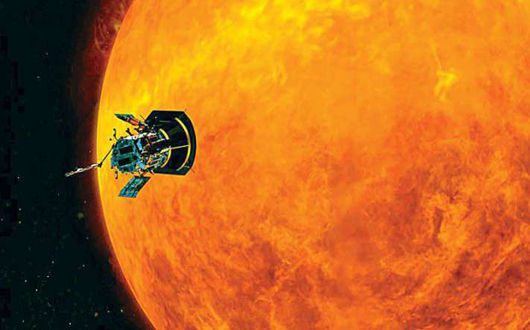TAMPA, Aug 11, 2018 (BSS/AFP) – The first ever spacecraft to fly directly
toward the Sun is poised to blast off Saturday, on a mission to plunge into
our star’s sizzling atmosphere and unlock the mysteries of the center of the
solar system.
NASA’s car-sized, $1.5 billion Parker Solar Probe is scheduled to launch
on a Delta IV Heavy rocket from Cape Canaveral, Florida during a 65-minute
launch window that opens at 3:33 am (0733 GMT).
By coming closer to the Sun than any spacecraft in history, the unmanned
probe’s main goal is to unveil the secrets of the corona, the unusual
atmosphere around the Sun.
“We are going to be in an area that is so exciting, where solar wind — we
believe — will be accelerating,” said NASA planetary science division
director Jim Green.
“Where we see huge magnetic fields that are passing by us, as coronal mass
ejections make their way out into the solar system.”
Not only is the corona about 300 times hotter than the Sun’s surface, but
it also hurls powerful plasma and energetic particles that can unleash
geomagnetic space storms, wreaking havoc on Earth by disrupting the power
grid.
But these solar outbursts are poorly understood.
“The Parker Solar Probe will help us do a much better job of predicting
when a disturbance in the solar wind could hit Earth,” said Justin Kasper, a
project scientist and professor at the University of Michigan.
Knowing more about the solar wind and space storms will also help protect
future deep space explorers as they journey toward the Moon or Mars.
– ‘Full of mysteries’ –
The probe is protected by an ultra-powerful heat shield that is just 4.5
inches (11.43 centimeters) thick.
The shield should enable the spacecraft to survive its close shave with
the fiery star, coming within 3.83 million miles (6.16 million kilometers) of
the Sun’s surface.
The heat shield is built to withstand radiation equivalent to up to about
500 times the Sun’s radiation on Earth.
Even in a region where temperatures can reach more than a million degrees
Fahrenheit, the sunlight is expected to heat the shield to just around 2,500
degrees Fahrenheit (1,371 degrees Celsius).
Scorching, yes? But if all works as planned, the inside of the spacecraft
should stay at just 85 degrees Fahrenheit.
The goal for the Parker Solar Probe is to make 24 passes through the
corona during its seven-year mission.
“The sun is full of mysteries,” said Nicky Fox, project scientist at the
Johns Hopkins University Applied Physics Lab.
“We are ready. We have the perfect payload. We know the questions we want
to answer.”
– 91-year-old namesake –
The tools on board will measure the expanding corona and continually
flowing atmosphere known as the solar wind, which solar physicist Eugene
Parker first described in 1958.
Parker, now 91, recalled that at first some people did not believe in his
theory.
But then, the launch of NASA’s Mariner 2 spacecraft in 1962 — becoming
the first robotic spacecraft to make a successful planetary encounter —
proved them wrong.
“It was just a matter of sitting out the deniers for four years until the
Venus Mariner 2 spacecraft showed that, by golly, there was a solar wind,”
Parker said earlier this week.
Parker said he was “impressed” by the Parker Solar Probe, calling it “a
very complex machine.”
Scientists have wanted to build a spacecraft like this for more than 60
years, but only in recent years did the heat shield technology advance enough
to be capable of protecting sensitive instruments, according to Fox.
Tools on board will measure high-energy particles associated with flares
and coronal mass ejections, as well as the changing magnetic field around the
Sun.
“We will also be listening for plasma waves that we know flow around when
particles move,” Fox added.
“And last but not least, we have a white light imager that is taking
images of the atmosphere right in front of the Sun.”
When it nears the Sun, the probe will travel rapidly enough to go from New
York to Tokyo in one minute — some 430,000 miles per hour, making it the
fastest human-made object.



